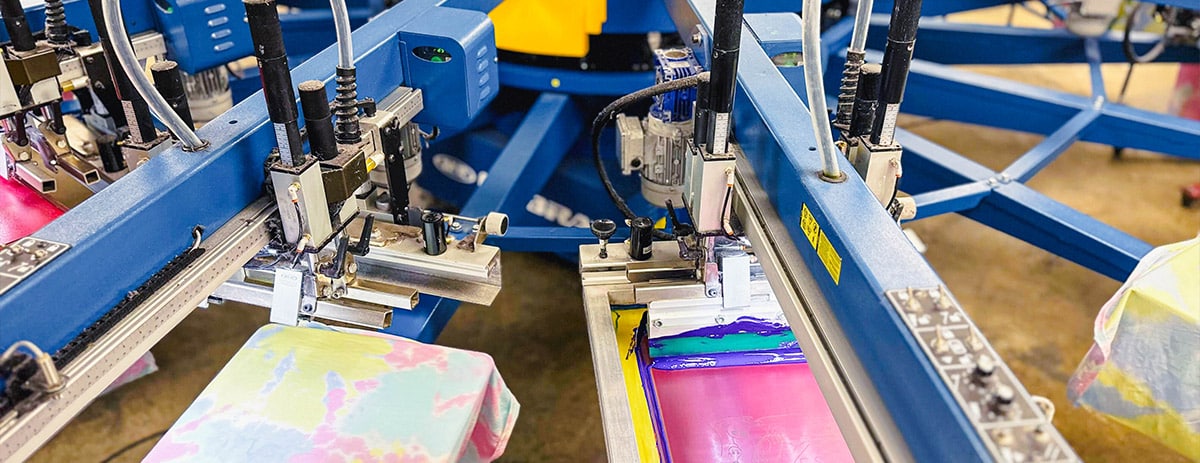Complete Screen Printing Kit for Artists and Creators
Complete Screen Printing Kit for Artists and Creators
Blog Article
Screen Printing Uncovered: Everything You Need to Learn About T-Shirt and Garment Printing Methods
Screen printing is a remarkable approach that integrates art with technique, providing unlimited possibilities for creativity. Ready to discover the important components that make display printing an art type?
The Essentials of Display Printing: How It Functions
When you plunge into display printing, you'll discover it's both a scientific research and an art. At its core, display printing includes developing a pattern, or screen, that permits ink to pass through just in specific areas (screen printing kit). You begin by picking your design and preparing your display with a light-sensitive emulsion. When you expose this emulsion to light, it solidifies, leaving your style as an adverse area.
Following, you'll mix your inks and prepare your printing surface. Position the display over the fabric, then use a squeegee to press ink with the display onto the garment. This process needs accuracy, as you want clear, lively prints. After printing, you'll treat the ink with heat, ensuring it sticks to the textile and lasts via washes. Each step is crucial, and mastering them will raise your screen printing skills, transforming simple garments into special, expressive pieces.
Sorts Of Display Printing Methods
When you comprehend the essentials of screen printing, it's time to discover the different methods that can boost your layouts. One popular approach is traditional screen printing, where ink is pushed via a stenciled screen. This method is wonderful for bold, vivid shades. After that there's water-based ink printing, which uses a softer feel and is eco-friendly, yet it needs a different strategy to treating.
Another alternative is plastisol printing, recognized for its sturdiness and dazzling shades, making it a favorite for several brands. Experiment with halftone printing to produce gradient effects and detailed designs.
Crucial Equipment for Display Printing
To accomplish magnificent outcomes in display printing, having the appropriate tools is essential. You'll need a durable display printing framework, which holds the mesh that moves your layout onto the garment. Next, spend in top notch mops; these are vital for using ink evenly throughout the screen.
Choosing the Right Inks and Materials
When picking inks and materials for display printing, you need to take into account the type of ink that functions finest for your job. Consider fabric compatibility to guarantee your designs look great and last long. Explore environmentally friendly ink alternatives to make your printing procedure extra lasting.
Kinds Of Display Inks
Choosing the best screen ink is essential for accomplishing vivid, resilient prints that fulfill your task's demands. There are numerous types of display inks to analyze. Specialized inks, such as metal or glow-in-the-dark, can add unique results to your designs.

Textile Compatibility Factors To Consider
Comprehending textile compatibility is vital for accomplishing high-quality screen prints, particularly since different products react uniquely to various inks. Always evaluate your inks on example textile to assure they stick correctly and preserve color honesty. In addition, maintain in mind that textile weight and appearance can influence the last end result, so selecting the best ink and material combo is vital for your job's success.
Eco-Friendly Ink Options
Eco-friendly inks are ending up being a preferred option for display printers who desire to reduce their ecological influence while keeping quality. When choosing inks, think about water-based inks, which are much less hazardous and easier to clean up contrasted to conventional solvents.
Furthermore, search for inks made from renewable energies, such as soy or vegetable-based options. By picking the appropriate inks and materials, you'll not only produce magnificent styles however additionally contribute to a more sustainable printing procedure. Make the button, and your prints will reflect your dedication to the setting!
Preparing Your Style for Screen Printing

Submit Layout Demands
To assure your style looks vivid and sharp on textile, you'll require to pay close focus to submit layout demands for screen printing. Make sure your layout has a transparent background to stop unwanted white edges on your prints. Maintain color modes in mind; CMYK is standard for screen printing, so transform your RGB develops as necessary.
Shade Separation Methods
Color separation is a necessary action in preparing your design for screen printing, and grasping it can greatly improve your print top quality. You'll require to break your layout into specific shades, as each color requires a separate display throughout printing. This accuracy not just assures precise shade representation however also simplifies the printing procedure.
Resolution and Size
Attaining the very best lead to display i thought about this printing starts with assuring your design has the appropriate resolution and size. Ideally, your art work must go to least 300 DPI (dots per inch) for sharp, clear prints. If you use reduced resolution, your end product could look amateur and pixelated.
When it involves dimension, take into consideration the measurements of your print area. Design your art work to match the last print dimension, ideally developing it in the actual measurements you'll be printing. In this manner, you'll prevent any unforeseen scaling problems.
Always check your style in both vector and raster styles. Vector graphics can be scaled without shedding quality, making them perfect for display printing. Preparing properly will ensure your design looks outstanding on every garment!
Step-by-Step Display Printing Process
Display printing is a dynamic procedure that allows you to develop dynamic designs on different surface areas. To begin, you'll require a display, emulsion, and your chosen ink. Prepare your display by cleansing it thoroughly. Next, use the emulsion equally and allow it completely dry in a dark location. As soon as dry, reveal your screen to light with your design positioned official site on it, which will certainly set the emulsion where the light hits, developing a pattern - screen printing kit.
After washing out the unexposed emulsion, your display is ready. Set it up on your printing surface and straighten your garment below it. Pour ink onto the screen and make use of a squeegee to press the ink with the pattern onto the fabric. Lift the screen thoroughly and allow the print completely dry. Finally, treat the ink making use of warmth to guarantee toughness. That's it! You've successfully screen printed your design.
Tips for Successful Screen Printing Projects
While you're diving into your screen printing tasks, remember that prep work is vital to success. Begin by gathering all your products-- inks, mops, screens, and garments. A clean work space assists stop undesirable errors, so clean prior to you begin.
Following, confirm your artwork is high-resolution and correctly sized for your garment. Examine your display for appropriate exposure and clean it extensively to stay clear of smudges. When blending your inks, adhere to the manufacturer's standards to attain the appropriate consistency.
Throughout printing, use even pressure with your squeegee for regular outcomes. Don't rush; take your time to verify each print meets your criteria. After printing, allow your garments dry entirely prior to dealing with or packaging them.
Last but not least, always maintain a sample of your benefit future referral. By doing this, you can evaluate your progression and improve your methods gradually. Satisfied printing!

Often Asked Inquiries
The length of time Does It Require To Establish a Screen Printing Work?
Establishing up a screen printing job generally takes around thirty minutes to an hour. You'll prepare the screens, mix inks, and adjust the press. The moment differs based upon complexity and experience, so check stay arranged!
Can I Publish on Different Material Enters Utilizing the Same Technique?
Yes, you can print on different fabric types using the same technique, but you'll require to readjust your inks and setups. Some materials take in ink in different ways, so experimenting guarantees the most effective outcomes for every product.
What Prevail Blunders to Stay Clear Of in Screen Printing?
When screen printing, avoid common mistakes like making use of the incorrect ink, overlooking proper direct exposure times, or missing pre-press checks. Always test your arrangement and keep clean screens to assure top quality outcomes each time.
How Can I Correctly Clean and Keep My Display Printing Devices?
To properly tidy and maintain your display printing equipment, you need to regularly clean screens with ideal solvents, check mops for wear, and ensure all tools are saved dust-free and dry. Uniformity stops expensive repairs and boosts performance.
Is Display Printing Eco-friendly Contrasted to Other Approaches?
Display printing can be a lot more eco-friendly than other approaches, especially if you make use of eco-conscious products and water-based inks. By selecting sustainable products and techniques, you lower waste and reduce your impact on the planet.
Screen Printing Uncovered: Every Little Thing You Required to Know About T-Shirt and Garment Printing Methods
At its core, display printing entails creating a stencil, or screen, that enables ink to pass via just in specific areas. Setting the display over the fabric, then make use of a squeegee to push ink with the display onto the garment. One popular technique is typical screen printing, where ink is pushed with a stenciled display.When choosing inks and materials for display printing, you require to take into account the kind of ink that works best for your task.
Report this page